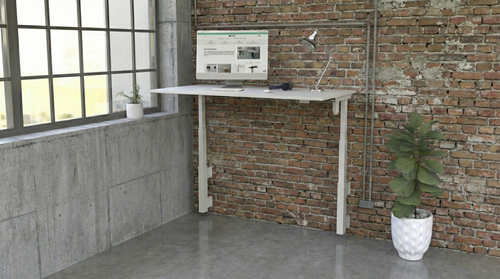In the digital age, where the majority of jobs involve sitting at a desk for extended periods, it has become increasingly important to prioritise our physical health and overall well-being while working. The way we set up our workstations plays a pivotal role in maintaining productivity, preventing musculoskeletal disorders, and fostering a sense of balance throughout the day.
Whether you find yourself immersed in the realm of creative design, tackling analytical tasks, or engaging in collaborative endeavours, we understand that each work style demands a unique approach to desk ergonomics. In today's article, we will explore the fascinating realm of ergonomic desk configurations tailored to different work styles.
For those who prefer a more conventional work style, a standard ergonomic desk setup can work wonders. Place your monitor at eye level, position your keyboard and mouse within easy reach, and adjust your chair for optimal posture. This configuration promotes a neutral and comfortable working position suitable for tasks that require focused attention and concentration.
The Multi-Monitor Maestro
If you thrive on multitasking or require multiple screens for your work, consider an ergonomic desk configuration that accommodates multiple monitors. Arrange your monitors in a slight curve to reduce strain on your neck and eyes. Utilise monitor arms or stands to adjust the height and angle of each monitor individually, ensuring optimal visibility and minimising the need for excessive head and eye movements.
The Creative Enthusiast
For artists, designers, or anyone engaged in creative work, an ergonomic desk configuration that prioritises space and flexibility is essential. Consider a height-adjustable drafting table or a desk with a tilting mechanism to accommodate various artistic mediums and techniques. Incorporate ample storage for art supplies and ensure good lighting for accurate colour representation. Personalise your workspace with inspiring artwork or mood boards to ignite creativity.
The Collaborative Team Player
If you often collaborate with colleagues or have frequent meetings, an ergonomic desk configuration that promotes collaboration and interaction is key. Opt for a desk with ample surface area to accommodate multiple people comfortably. Consider a round or oval-shaped table to encourage conversation and maintain eye contact. Use cable management solutions to keep wires tidy and avoid trip hazards, creating a safe and inviting space for teamwork.
The Minimalist Zen Seeker
An ergonomic desk configuration that promotes simplicity and mindfulness is ideal for those who embrace a minimalist and clutter-free approach to work. Choose a sleek and streamlined desk with built-in storage solutions to keep your workspace tidy. Incorporate a plant or a small Zen garden for a touch of nature and tranquillity. Utilise cable management systems to hide wires and create a clean aesthetic. This configuration helps create a peaceful and focused environment for maximum productivity.
The Active Workaholic
If you prefer to incorporate movement into your work routine, consider an ergonomic desk configuration that supports an active work style. Opt for a height-adjustable desk that allows you to switch between sitting and standing positions. Incorporate a balance board or a wobble cushion to engage your core and promote movement while working. Arrange your workstation to encourage walking breaks, such as placing frequently used items at a distance. This configuration helps improve circulation, reduce sedentary behaviour, and boost energy levels.
The Remote Worker
For those who work from home or remotely, creating a dedicated ergonomic workspace is crucial. Designate a separate area in your home for work, preferably away from distractions. Invest in a comfortable ergonomic chair, a height-adjustable desk, and proper lighting to mimic the conditions of a professional office. Use noise-cancelling headphones or consider soundproofing options to minimise distractions. This configuration helps establish boundaries between work and home life, fostering a productive remote work environment.
We have explored a range of ergonomic desk configurations tailored to different work styles, recognising that each style demands a unique approach. From the traditionalist seeking a standard ergonomic setup to the multi-monitor maestro juggling multiple screens, from the creative enthusiast requiring flexibility to the collaborative team player fostering interaction, and from the minimalist zen seeker seeking simplicity to the active workaholic incorporating movement, we have provided practical recommendations for every work style.
It is paramount for remote workers to create a dedicated ergonomic workspace at home to establish boundaries and promote a productive remote work environment. With the right equipment, proper lighting, and an area free from distractions, remote workers can create an environment conducive to focus and efficiency.
Remember, the key to achieving an optimal ergonomic desk configuration lies in understanding your unique needs, experimenting with different setups, and prioritising your well-being. By implementing the suggestions discussed in this article, you can transform your workspace into a haven of health, productivity, and overall wellness.









































